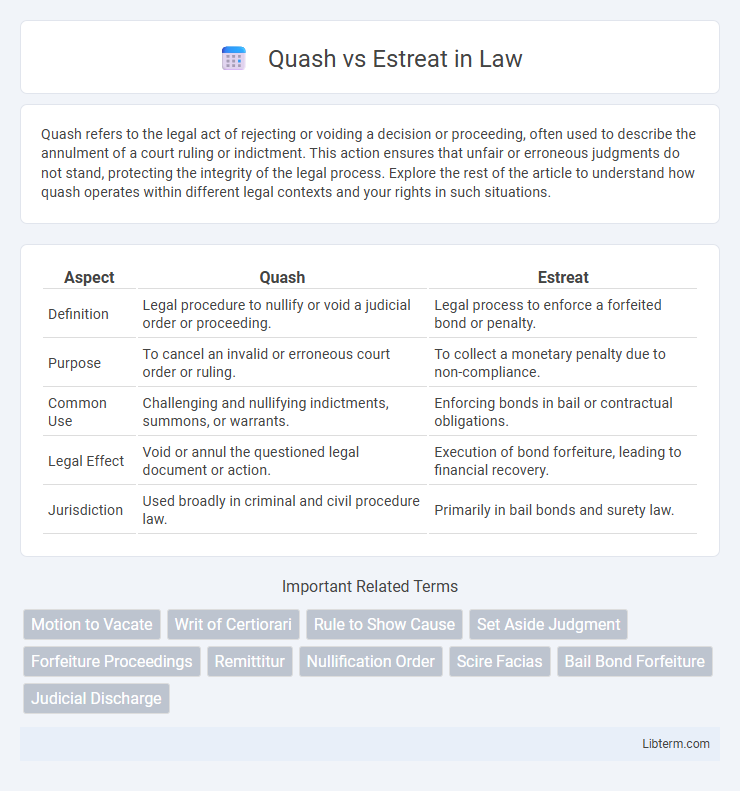Quash refers to the legal act of rejecting or voiding a decision or proceeding, often used to describe the annulment of a court ruling or indictment. This action ensures that unfair or erroneous judgments do not stand, protecting the integrity of the legal process. Explore the rest of the article to understand how quash operates within different legal contexts and your rights in such situations.
Table of Comparison
| Aspect | Quash | Estreat |
|---|---|---|
| Definition | Legal procedure to nullify or void a judicial order or proceeding. | Legal process to enforce a forfeited bond or penalty. |
| Purpose | To cancel an invalid or erroneous court order or ruling. | To collect a monetary penalty due to non-compliance. |
| Common Use | Challenging and nullifying indictments, summons, or warrants. | Enforcing bonds in bail or contractual obligations. |
| Legal Effect | Void or annul the questioned legal document or action. | Execution of bond forfeiture, leading to financial recovery. |
| Jurisdiction | Used broadly in criminal and civil procedure law. | Primarily in bail bonds and surety law. |
Introduction to Quash and Estreat
Quash refers to the legal act of nullifying or setting aside a previous court order or decision, often due to procedural errors or lack of jurisdiction. Estreat involves the formal process of enforcing a recognizance or bond by converting it into a judgment, typically to recover penalties or fines owed to the court. Understanding the distinction between quash and estreat is essential in legal proceedings where the validity of orders and enforcement of obligations are contested.
Legal Definitions: Quash vs Estreat
Quash refers to the legal action of nullifying or setting aside a court order, judgment, or writ due to errors or irregularities, effectively rendering it invalid. Estreat is the process of converting a recognizance or bond into a judgment, allowing the court to enforce payment or penalties if the conditions of the bond are breached. Understanding the distinction: quashing cancels the legal effect of a document, while estreating enforces its obligations through judicial authority.
Historical Background of Both Terms
Quash and estreat originate from common law, where quash refers to the annulment or cancellation of a legal proceeding or document, often used to nullify indictments or warrants. Estreat historically involved the process of enforcing a forfeiture or penalty by extracting the record of a bond or recognizance from the court to the treasury or a designated authority. Both terms have evolved from medieval English law, reflecting the judicial mechanisms for managing legal errors and financial penalties.
Key Differences Between Quash and Estreat
Quash refers to the court's act of annulling or setting aside a legal proceeding or document, often due to procedural errors or lack of jurisdiction. Estreat involves the formal process of enforcing a penalty or forfeiture, typically converting a bond or recognizance into a monetary judgment. Key differences lie in quash being a defensive measure to nullify invalid actions, whereas estreat is an offensive step to collect funds due to non-compliance or breach.
When to File a Motion to Quash
File a motion to quash when challenging the validity of a subpoena, summons, or indictment due to defects such as improper service, lack of jurisdiction, or insufficient process. The motion must be filed before the court takes further action on the case, typically prior to responding to the complaint or appearing in court. Courts generally require timely submission to ensure procedural fairness and prevent unnecessary delays.
Understanding the Process of Estreat
Estreat involves the official process of converting a bond, recognizance, or surety into a fine or penalty by a court, typically after a party fails to meet their obligations. This legal mechanism enables the government or creditor to enforce financial penalties by seizing or claiming the bond amount. Understanding estreat requires recognizing its role in judicial enforcement, procedural requirements such as filing notices, and the consequences for the bonded party.
Implications of Quashing a Case or Writ
Quashing a case or writ results in the complete nullification of the legal proceeding or order, rendering it void as if it never existed. This action eliminates any further legal consequences or enforcement related to the original writ or case. The implication of quashing is a reset in the legal status, often used to correct procedural errors or address jurisdictional defects, ensuring that invalid or improperly issued legal actions do not impede justice.
Legal Consequences of Estreatment
Estreating a bond or recognizance results in the forfeiture of the pledged amount, compelling the principal or surety to pay the full bond value to the court. The legal consequence of estreatment includes the entry of a judgment against the obligor, which may lead to enforced collection measures like wage garnishment or asset seizure. Estreatment serves as a formal mechanism ensuring compliance with court orders by penalizing failure to fulfill bond obligations.
Real-World Examples: Quash and Estreat in Practice
Quash and estreat serve distinct functions in legal practice, with quash typically involving the annulment of a judicial proceeding or order, such as quashing a subpoena in a criminal trial to protect a defendant's rights. Estreat refers to the enforcement of a forfeited bond, demonstrated when a bail bond is estreated after the defendant fails to appear in court, leading to the forfeiture of the bond amount. Real-world cases often highlight quash as a tool to uphold procedural fairness, while estreat ensures compliance and financial penalties in bond-related matters.
Conclusion: Choosing Between Quash and Estreat
Choosing between quash and estreat hinges on the legal context and desired outcome; quash nullifies or cancels a judicial proceeding or order due to defects, whereas estreat involves enforcing a bond or financial penalty after default. Courts typically apply quash to procedural errors or invalid writs, while estreat is executed to recover funds from forfeited guarantees. Legal professionals must evaluate case specifics, such as error presence or bond forfeiture, to determine the appropriate remedial action.
Quash Infographic

 libterm.com
libterm.com